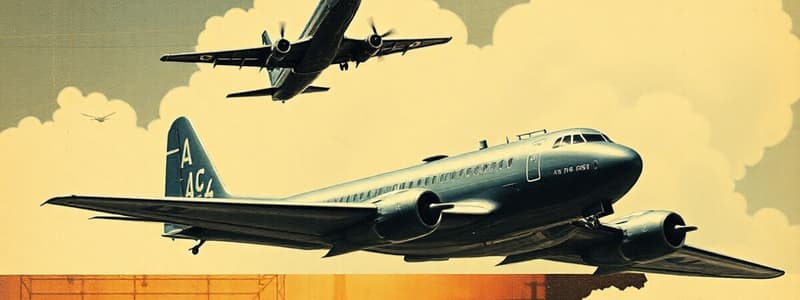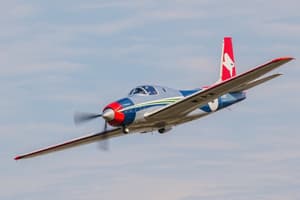Podcast
Questions and Answers
What is the primary function of leading-edge high-lift devices?
What is the primary function of leading-edge high-lift devices?
- To decrease drag during flight
- To improve fuel efficiency
- To retract wing flaps
- To extend the lift curve to a higher angle (correct)
In a fully extended configuration of high-lift devices, what happens to the thrust?
In a fully extended configuration of high-lift devices, what happens to the thrust?
- Thrust decreases to idle (correct)
- Thrust fluctuates intermittently
- Thrust remains constant
- Thrust increases to maximum
What is a characteristic of a Kruger flap compared to a Fowler flap?
What is a characteristic of a Kruger flap compared to a Fowler flap?
- The Kruger flap moves downwards and forwards (correct)
- The Fowler flap is primarily used on smaller aircraft
- The Fowler flap is more effective at low speeds
- The Kruger flap increases the wingspan significantly
What happens to the actual value of lift when a flap hinge is increased?
What happens to the actual value of lift when a flap hinge is increased?
What is the role of the slat driving mechanism?
What is the role of the slat driving mechanism?
What is the result of using flaps on an aircraft?
What is the result of using flaps on an aircraft?
Which aspect does the lift-to-drag ratio (L/D) reflect?
Which aspect does the lift-to-drag ratio (L/D) reflect?
What is a consequence of a thin wing with a sharp leading edge?
What is a consequence of a thin wing with a sharp leading edge?
What is the stall speed of an empty fuel tank for the Lockheed F-104G?
What is the stall speed of an empty fuel tank for the Lockheed F-104G?
What happens to the lift curve when high lift devices are deployed?
What happens to the lift curve when high lift devices are deployed?
How can Boeing 727 achieve a low stall speed?
How can Boeing 727 achieve a low stall speed?
Which type of flap has the greatest effect on increasing lift?
Which type of flap has the greatest effect on increasing lift?
What does the maximum lift coefficient influence in an aircraft?
What does the maximum lift coefficient influence in an aircraft?
What maximum lift coefficient did the Boeing 727 achieve when fully deployed?
What maximum lift coefficient did the Boeing 727 achieve when fully deployed?
Which design feature is important for minimizing takeoff and landing distances in the Boeing 727?
Which design feature is important for minimizing takeoff and landing distances in the Boeing 727?
How can effective camber be increased?
How can effective camber be increased?
Which of the following describes the impact of leading-edge and trailing-edge flaps on lift?
Which of the following describes the impact of leading-edge and trailing-edge flaps on lift?
What is a consequence of increasing wing area on the Boeing 727?
What is a consequence of increasing wing area on the Boeing 727?
What kind of flap design does the Boeing 727 utilize at the trailing edge?
What kind of flap design does the Boeing 727 utilize at the trailing edge?
What is the relationship between camber and flap deflection at the trailing edge?
What is the relationship between camber and flap deflection at the trailing edge?
What is a potential disadvantage of achieving a large wing area in airplane design?
What is a potential disadvantage of achieving a large wing area in airplane design?
Flashcards
High-Lift Devices
High-Lift Devices
These are mechanisms used to increase lift on an aircraft's wings. They are deployed during takeoff and landing to provide more lift at lower speeds.
Leading-Edge Slat
Leading-Edge Slat
A thin, curved surface deployed in front of the wing's leading edge to delay airflow separation at high angles of attack, increasing lift.
Kruger Flap
Kruger Flap
A type of leading-edge device that extends forward from the wing's leading edge, increasing the wing's camber for more lift.
Fowler Flap
Fowler Flap
Signup and view all the flashcards
What is lift augmentation?
What is lift augmentation?
Signup and view all the flashcards
Effect of High Lift Devices
Effect of High Lift Devices
Signup and view all the flashcards
What are slats?
What are slats?
Signup and view all the flashcards
How do slats increase lift?
How do slats increase lift?
Signup and view all the flashcards
How do flaps affect lift?
How do flaps affect lift?
Signup and view all the flashcards
What are the effects of flaps on airfoil characteristics?
What are the effects of flaps on airfoil characteristics?
Signup and view all the flashcards
What is the lift-to-drag ratio (L/D)?
What is the lift-to-drag ratio (L/D)?
Signup and view all the flashcards
What is the maximum lift coefficient?
What is the maximum lift coefficient?
Signup and view all the flashcards
What are the benefits of high-lift devices?
What are the benefits of high-lift devices?
Signup and view all the flashcards
Stall Speed
Stall Speed
Signup and view all the flashcards
Factors Affecting Stall Speed
Factors Affecting Stall Speed
Signup and view all the flashcards
Wing Planform Area (S)
Wing Planform Area (S)
Signup and view all the flashcards
Maximum Lift Coefficient (CL,max)
Maximum Lift Coefficient (CL,max)
Signup and view all the flashcards
Trailing Edge Flap
Trailing Edge Flap
Signup and view all the flashcards
Camber
Camber
Signup and view all the flashcards
TE Flap Deflection
TE Flap Deflection
Signup and view all the flashcards
Study Notes
Forces Acting on an Aircraft
- Four main forces act on an aircraft: Thrust, Lift, Drag, and Weight.
- Thrust propels the aircraft forward, opposing drag.
- Lift counters weight, allowing the aircraft to stay aloft.
- Drag is the force that resists the aircraft's motion through the air.
- Weight is the force of gravity acting on the aircraft.
Lift Augmentation
- Trailing-edge flaps increase lift and decrease stall speed, allowing for slower flight speeds while maintaining control.
- They are particularly important during approach and landing.
- This helps maintain control at lower speeds.
Lift Augmentation - Slats
- Slats are leading-edge devices that delay airflow separation at higher angles of attack.
- They prevent stalls by maintaining airflow over the wing.
- Using a slot in the wing also delays airflow separation.
Slat Types
- Some slats are automatically deployed at predetermined angles of attack.
- Another slat type can be controlled manually by the pilot.
- Both are positioned ahead of the ailerons to maintain lift past the wing root.
Lift Augmentation Graph
- The graph displays how lift coefficient (Cl) changes with angle of attack (α).
- Different configurations of flaps and leading-edge slats impact the lift coefficient and angle of attack.
- The graph demonstrates that the lift coefficient increases with flaps and slats deployed.
- Different flap and slat combinations have different outcomes on the lift generated.
Deflection of Flaps
- Deflecting flaps effectively increases the camber, or curvature, of the wing.
- This camber creates a virtual increase in the angle of attack, resulting in more lift.
Impact of High-Lift Devices
- High-lift devices increase the maximum lift coefficient (Cl,max) of an aircraft.
- These devices shift the lift curve to the left, decreasing the stall speed (Vstall).
- This means the aircraft can fly at a lower airspeed during takeoff and landing.
- The increase or decrease in lift depends on the position of the high lift devices.
Aerodynamic Effect of Flap Models
- Various flap types (plain, split, slotted, and Fowler) have different effects on lift and drag characteristics.
- The type of flap affects the lift coefficient and drag coefficient at various angles of attack.
- Different flap types generate varying drag and lift outputs.
Figures of Merit
- L/D (lift-to-drag ratio) represents aerodynamic efficiency, a higher ratio is desirable.
- Range is directly proportional to L/D.
- Cl,max (maximum lift coefficient) determines stall speed, higher values are beneficial.
- High Cl,max is important for take-off and landing performance.
Types of Flaps
- Plain flaps, split flaps, slotted flaps, and Fowler flaps are different flap types on an aircraft.
- Each type has different characteristics and uses.
- Specific diagrams illustrating each flap type's appearance on an aircraft are presented.
Plain Flap
- Boundary layer separation over the wing results in wake turbulence.
- A plain flap is a simple extension of the trailing edge.
Split Flap
- Boundary layer separation and wake turbulence occur over the wing trailing edge.
- A split flap is a simple extension of the trailing edge.
Slotted Flap
- High-pressure air flows through the slot, minimizing boundary layer separation over the wing trailing edge.
- Delaying airflow separation with a slot.
Fowler Flap
- High-lift device that effectively increases lift and camber.
- Extension extends the chord and moves downward or forward of the wing trailing edge.
Slat
- Leading-edge device, commonly used to delay stall.
- Deployed position and effect on airflow over the wing.
- Used in modern airplane design to effectively control lift and stall speed.
Leading Edge High-Lift Devices
- LE slat, LE droop, and Kruger flap are types of leading-edge devices.
- These devices extend in front of the leading edge of the wing.
- They extend the maximum lift curve to higher angles of attack, delaying stall.
The Effect of Leading Edge Slat Deflection
- Extending a slat extends the maximum lift coefficient and extends the region where lift can be achieved to higher angles of attack.
- No change to alpha zero.
- No change to the lift coefficient at zero degrees of angle of attack.
High Lift Devices
- High lift devices increase the maximum lift coefficient which then decreases the stall speed, useful during take off and landing operations.
- Different configurations for high lift devices are illustrated and explained.
Three Configuration of High Lift Devices
- High lift devices are deployed for different flight phases.
- Illustrations of high lift devices during various flight conditions.
- The effect of the high lift devices on the aircraft lift coefficients under various flight conditions
Driving Mechanism of Slat
- Diagrams of mechanical components involved in slat deployment and retraction.
- Different components for controlling the slat extension/retraction.
Leading Edge High Lift Devices
- Detailed diagrams showcasing different leading-edge high-lift device types.
- Illustrative diagrams of devices, both retracted and extended.
- Information comparing the features of the different devices.
Kruger Flap - B737
- Kruger flap on a B737 is illustrated and described
- Diagrams illustrate the structure of the Kruger flap (B737).
Kruger Flap VS Fowler Flap
- Comparison between the Kruger and Fowler flaps, diagrams highlighting the structural differences.
Slat Driving Mechanism (using slat track):
- Mechanism for deploying slats is shown.
- The illustrations show the components in detail.
Conclusion
- Summary of topics covered in the section.
- Students should be able to apply the knowledge.
Studying That Suits You
Use AI to generate personalized quizzes and flashcards to suit your learning preferences.




